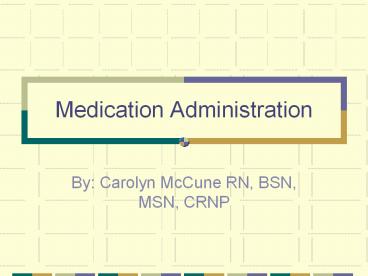Medication Administration - PowerPoint PPT Presentation
Title:
Medication Administration
Description:
Medication Administration By: Carolyn McCune RN, BSN, MSN, CRNP * PLACEMENT-30 ml water-med-10 ml water-med-30 ml water. Should give one med at a time. – PowerPoint PPT presentation
Number of Views:83
Avg rating:3.0/5.0
Title: Medication Administration
1
Medication Administration
- By Carolyn McCune RN, BSN, MSN, CRNP
2
Percutaneous Administration
- Medications application to the skin or mucus
membranes - Ointments, creams, powders, lotions, solutions
into the mouth, eye, ear, nose, or vagina.
Medications inhaled into the lungs - Reduced incidence of side effects but can be
messy.
3
Creams, lotions and ointments
- Creams
- Lotions
- Ointments
- Patient teaching-Very important if patient or
family administering - Always review the 6 patient rights for drug
administration.
4
Dressings
- Medicated dressings to treat wounds
- Some protect
5
Patch Testing for Allergens
- To identify sensitivity to allergens
- The antigens are placed in direct contact with
the skin and read in 3 and 7 days. - May vary with testing
- A redness or swelling will occur if positive
6
Nitroglycerin Ointment
- Used for relief of anginal pain
- Appying
- Always wear gloves
- Measure appriopriate amount
- Rotate application site
- Cover with plastic wrap and tape in place
- Wash hands after applying
- Education and teaching
7
Transdermal Delivery Systems
- Transdermal disk-controlled release of
medication. - Applying the disk
- Education to patient
8
Medications to Mucous Membranes
- Buccal tablets/Sublingual meds
- Technique and Education
- Eye Drops and ointments
- Techniques and Education
- Nose drops
- Techniques and Education
9
Mucous Membranes Continued
- Ear drops
- Infants-pull earlobe down and back under 3 years
of age - Adults and over 3 years-pull up and back
- Education
- Nose drops and sprays
- Technique and Education
10
Medications by Inhalation
- Nebulae-sprayed into throat by nebulizer
- Aerosols-use a flow of air or oxygen uder
pressure to get medications into the respiratory
tract. May be done by respiratory therapy. - Education
- Vaginal medications(applicators, suppositories,
and douches. - Technique and education
11
Starts Chapter 9
- Enteral meds-drugs enter directly into the GI
tract - Oral, tube, rectal
12
Administering Meds
- Unit dose(single dose)
- Souffle cup
- Medicine cup
- dropper
- Teaspoon
- Oral syringe
- Nipple
13
Enteral Administration
- Enteral-into the GI tract by oral, rectal or
nasograstic. Safest and most conventient - Slowest and least dependable
- NG method-if unable to swallow
- Rectal route bypassing the digestive system and
avoids stomach irritation.
14
Oral administration
- Dose forms
- Capsules
- Time released
- Lozenges
- Pills
- Tablets
- Emulsions
- Suspensions
- Syrups
15
Medications by Nasogastric,Gastrostomy, or
JejunostomyTube
- Liquid form of drug if available
- Tablet form
- Always flush with water
16
Rectal Suppositories and Enemas
- Technique
- Education
- Review Always use 6 medication right
- Must know how to education the patient and family
regarding administration of meds
17
Start Chapter 10
- Parenteral administration-
18
Parenteral administration
- Route other than the enteral or GI tract
- Subcutaneous
- Intramuscular or
- Intravenous
- Onset more rapid, less dosage
19
Administration of medications by route other than
GI tract
- This will be covered in lab
- You must know sites for SC and IM
injections-please review prior to lab
20
Intradermal Route
- Injected to produce a Wheal
- Absorption is slow
- Technique and education































